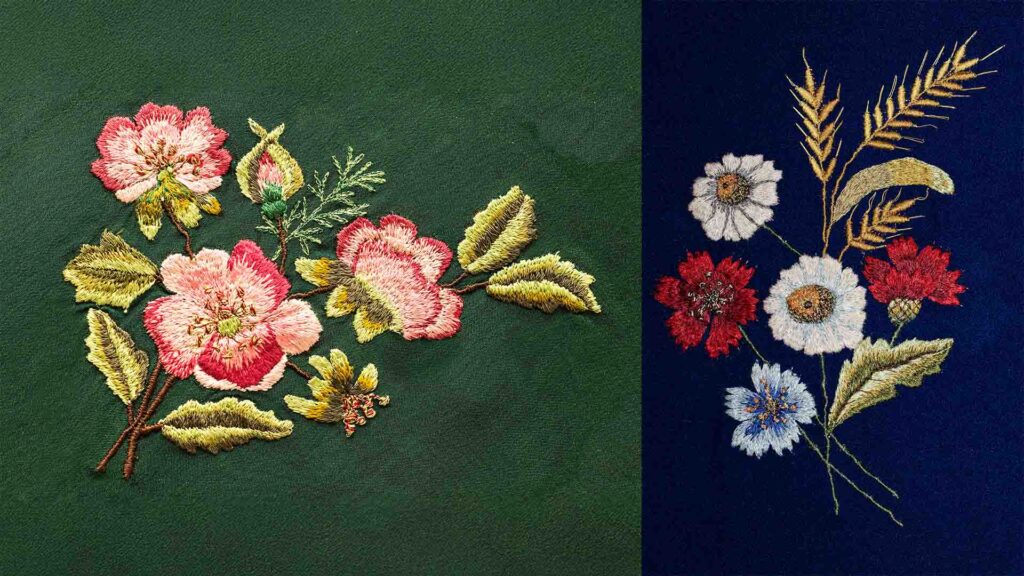
Embroidery has always been an expression of culture, creativity, and craftsmanship. My journey began in the vibrant city of Delhi, where I worked for two years in a boutique garment company, specializing in khaka embroidery design. This blog post showcases my experience, the types of garments I worked on, and samples of my original embroidery designs—all aimed to inspire, educate, and rank well on search engines like Google.
✨ What is Khaka Embroidery Design?
Khaka embroidery (also spelled Khaaka) is a traditional method of tracing embroidery patterns on paper or fabric before actual stitching begins. These hand-drawn blueprints serve as detailed guides for artisans to follow.
This art form demands high precision and creativity, as each line in the khaka sets the foundation for the final embroidered piece. In boutiques, khaka artists like me help convert fashion designers’ ideas into tangible embroidery blueprints.
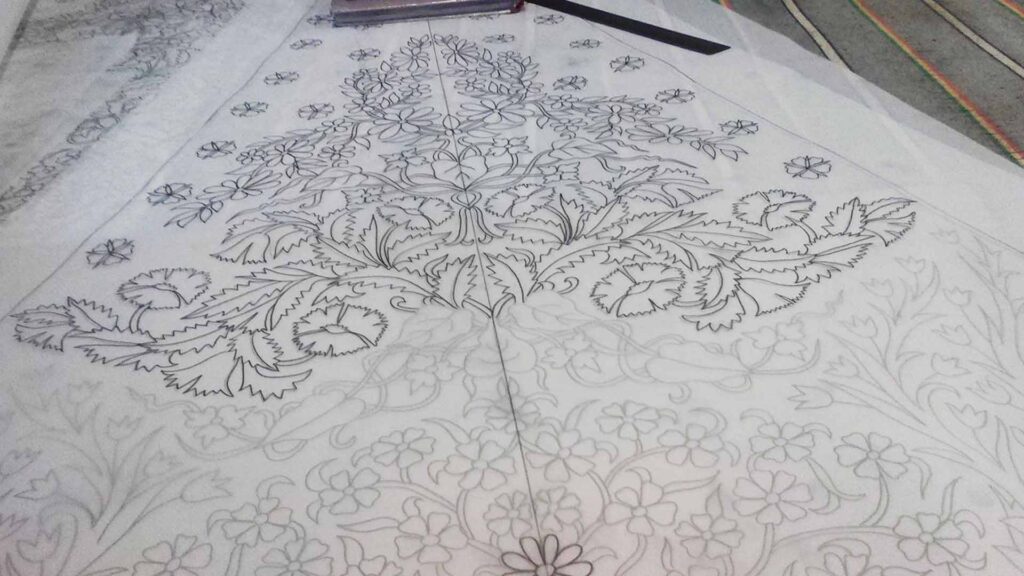
🏙️ My Experience in a Delhi-Based Boutique
During my two years in Delhi, I worked closely with fashion designers, tailors, and clients to create embroidery designs for:
- Bridal wear
- Lehenga cholis
- Saree borders
- Blouse pieces
- Kurtis and salwar suits
- Western fusion dresses
My job was to prepare khaka designs using tracing sheets, pencil, and tools like kerosene for dotting, and white or yellow chalk powder for transferring to fabric. Each design was then passed to hand-embroidery workers who brought it to life with zardosi, beads, resham threads, mirror work, and more.
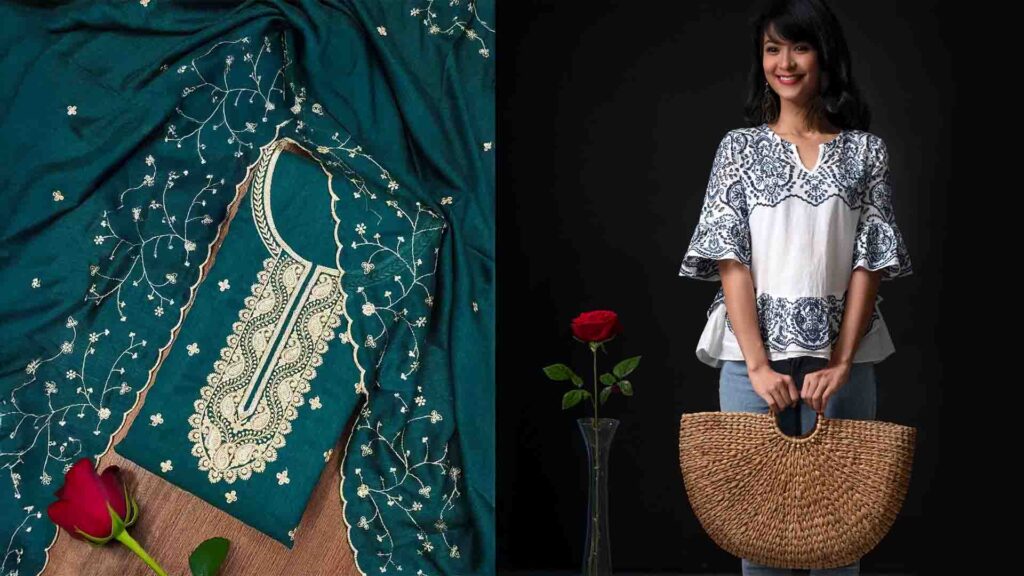
🧵 Types of Garment Embroidery Designs I Created
Let me share the main categories of designs I worked on:
1. Floral Embroidery Designs
Elegant flowers, vines, and leaves are timeless. These were popular for:
- Saree pallu & borders
- Kurti necklines
- Dupatta corners
2. Peacock and Traditional Motifs
Peacock patterns, kalash, elephants, and paisley motifs were commonly used in:
- Bridal lehengas
- Dupattas
- Temple-style outfits
3. Geometric and Modern Art
Boutiques also required minimal, modern, and symmetrical designs for:
- Indo-western gowns
- Office-wear kurtis
- Designer crop tops
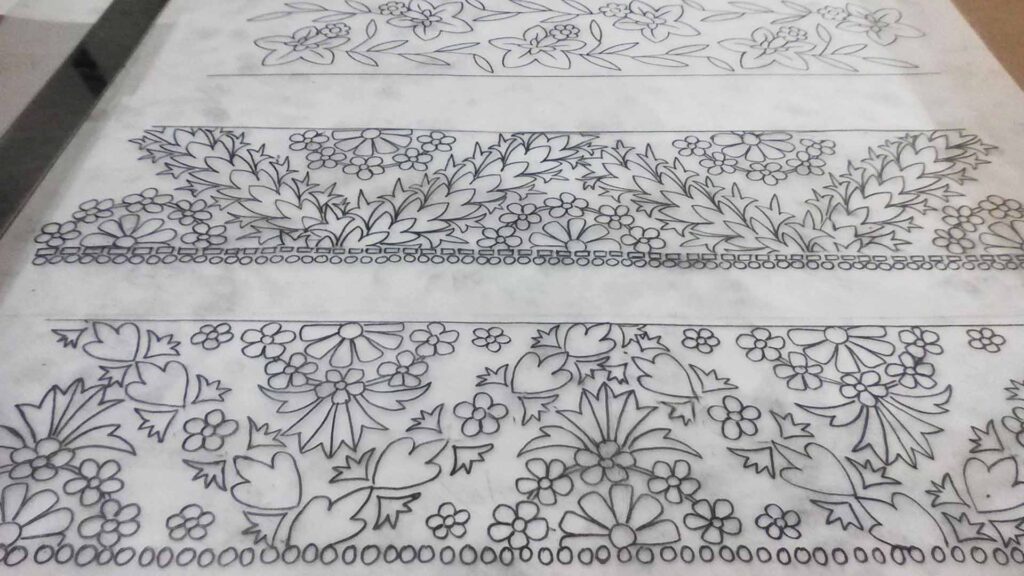
4. Heavy Zardosi Designs
I created khakas for zardosi embroidery that involved:
- Dabka work
- Cutdana
- Kundan and pearl embroidery
- Sequin and mirror work
5. Border & Butta Designs
Used for:
- Saree edges
- Blouse sleeves
- Lehenga ghera
- Kids’ ethnic wear
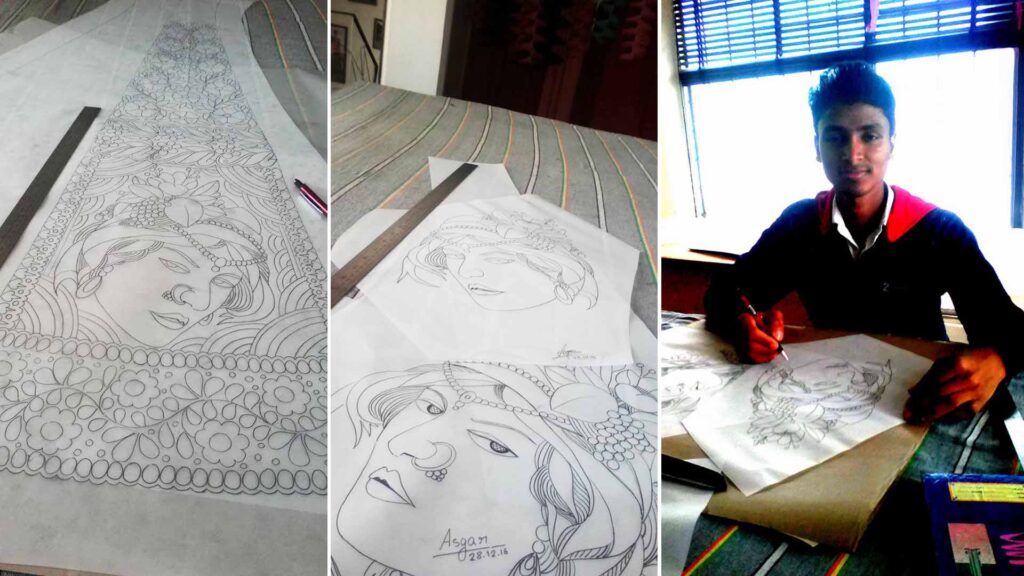
🖼️ Some Samples of My Embroidery Design Work
Below are actual khaka designs I created. Each of them represents a unique approach, depending on garment type and client preference:
- EMB Design 01 – Floral border with vine elements—used for dupattas
- EMB Design 02 – Circular mandala motifs—suitable for lehenga flair
- EMB Design 03 – Fine neckline design for bridal blouses
- EMB Design 04 – Peacock motif with zardosi base—lehenga choli
- EMB Design 05 – Mirror-work khaka for kurti front design
- EMB Design 06 – Traditional paisley border for sarees
- EMB Design 07 – Minimalist pattern for western fusion tops
- EMB Design 08 – Bridal heavy pattern for full-sleeve blouse
- EMB Design 09 – Butta work, small and repeated—used for dupattas
- EMB Design 10 – Rich floral arch—ideal for back blouse design
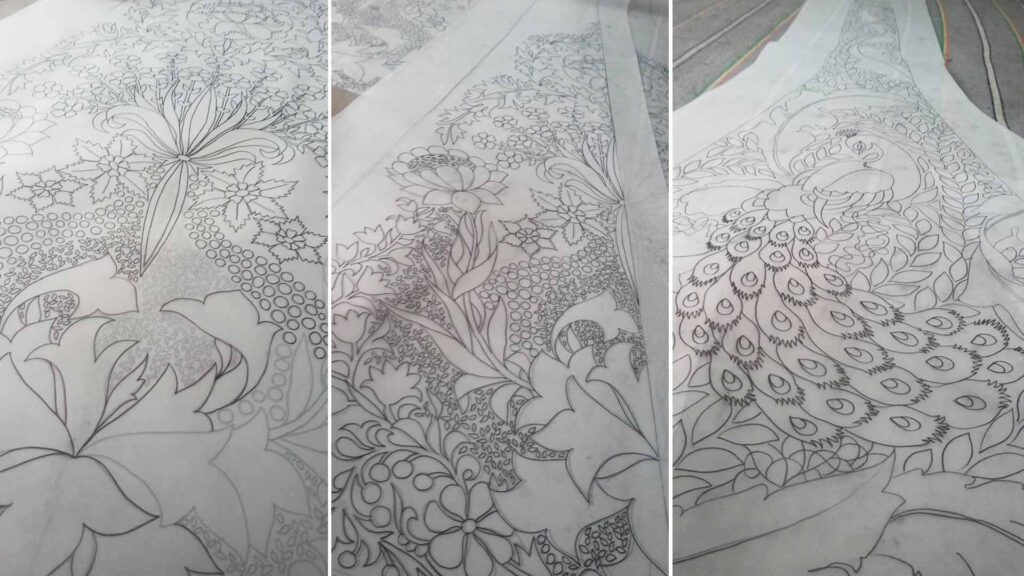
💡 What I Learned
Working in the garment design industry taught me:
- The importance of fine detail in handmade design
- How to translate designer vision into technical patterns
- Deep knowledge of fabric types, embroidery threads, and materials
- Collaboration between designers, tailors, and embroidery artists
- Meeting tight deadlines while maintaining artistic quality
🧑🎨 My Creative Mission Now
Today, I continue using my embroidery background in digital art, graphic design, and content creation. My aim is to:
- Share embroidery stories from India’s roots
- Teach youth about the value of handcraft
- Promote handmade and digital fusion design
- Attract freelance and custom embroidery work
If you’re a designer, boutique owner, or art lover—let’s collaborate!

🛠️ Tools & Equipment Used for Khaka Embroidery Design
To create precise and professional khaka designs, I used a variety of traditional tools and simple equipment. Here’s a list of the essential items:
✏️ Basic Drawing Tools
- Tracing paper or butter paper
- White sheet or tissue paper
- Pencil (2B or 4B) – for soft, bold lines
- Eraser & scale – for accurate measurement and corrections
- Perforator or needle tool – to punch holes for transferring designs
🧪 Transferring Tools
- Kerala oil / kerosene – used to prepare sheets for dotting
- White or yellow chalk powder – mixed with kerosene to transfer the design
- Fine mesh cloth – for evenly sprinkling chalk dust
🧵 Design Enhancing Tools
- Compass, French curves, and stencils – for symmetric and round shapes
- Fine-tip black pen – for final outlining
- Carbon paper – sometimes used for dark fabric transfers
- Cutting board or soft board – to protect surfaces while perforating
🪡 Fabric Handling Items
- Wooden frame or hoop – to stretch fabric if direct tracing is done
- Masking tape – to fix the khaka onto fabric during transfer
- Clips and pins – to hold layers in place
These tools helped me maintain accuracy, speed, and clean design output, especially when working under boutique deadlines.
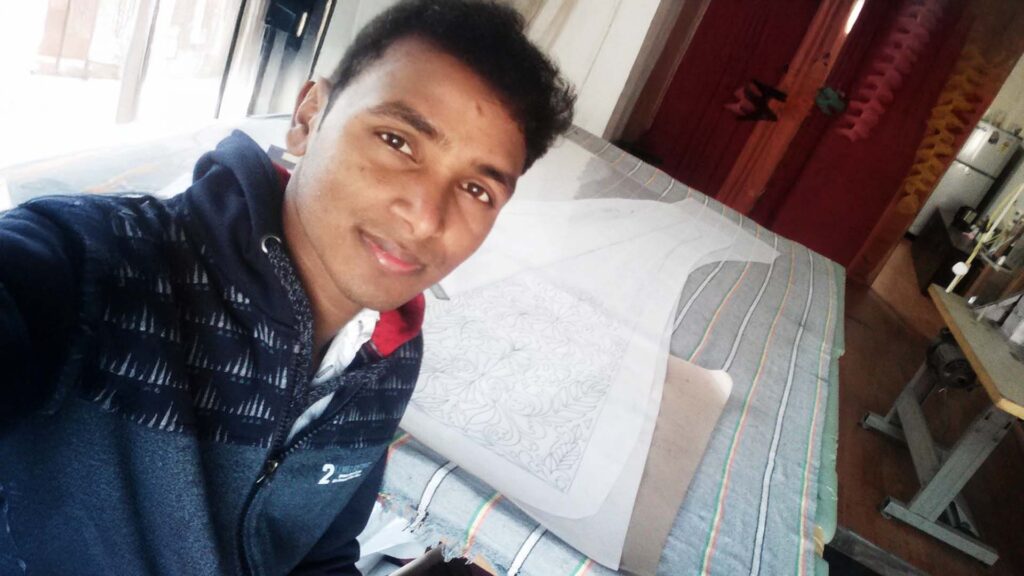
📐 Step-by-Step Guide: How Khaka Embroidery Designs Are Made
Here’s a clear and practical workflow of how khaka designs are created and used in embroidery production:
1. Design Sketching
- Discuss garment style and client preferences.
- Draw the initial sketch on tracing paper using pencil and stencils.
- Use symmetry and reference images if needed.
2. Finalizing the Outline
- Go over the pencil sketch using a fine black pen or darker pencil.
- Ensure design accuracy—no uneven lines or unnecessary marks.
3. Perforation (Dotting)
- Use a needle tool or pin to perforate along the entire outline.
- Ensure consistent spacing in the holes for clear design transfer.
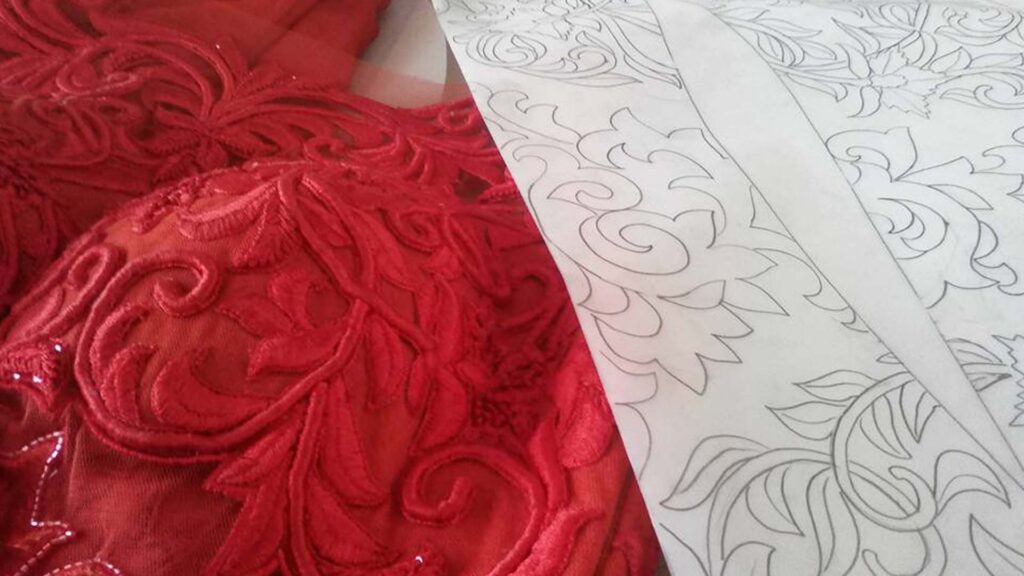
4. Preparing the Fabric
- Spread the fabric on a flat surface.
- Fix the khaka on the fabric using masking tape or clips.
5. Chalk Powder Transfer
- Mix chalk powder with a small amount of kerosene.
- Use a fine mesh or soft cloth to rub over the perforated khaka.
- The powder seeps through the holes and leaves a dotted design on the fabric.
6. Embroidery Execution
- Once transferred, hand embroiderers or machine artists begin their work.
- Embroidery threads, zardosi, stones, or sequins are stitched along the dotted design.
7. Quality Check
- After embroidery, ensure the design is centered, clean, and symmetrical.
- Wash off any extra chalk or tracing marks if needed.
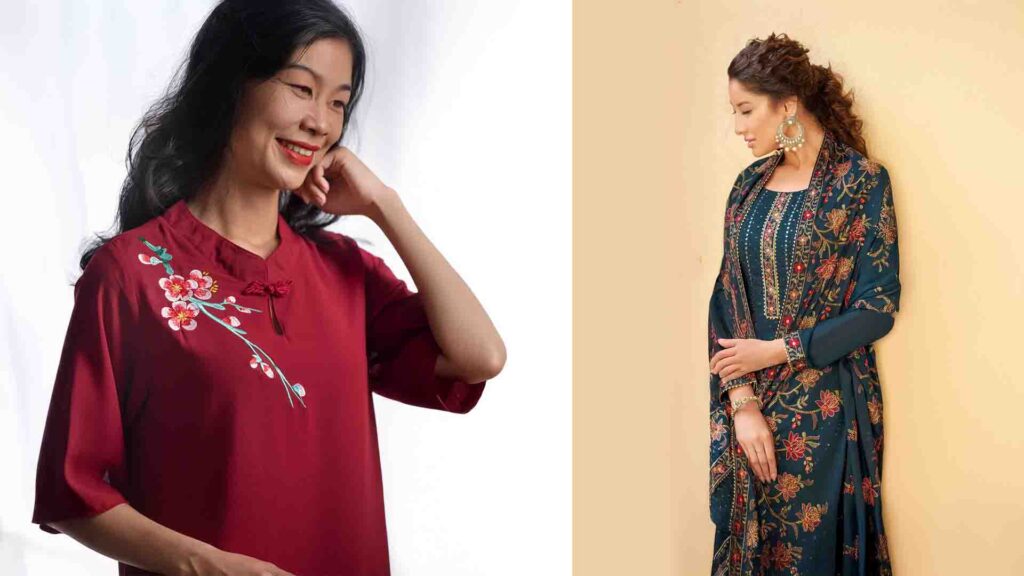
🧠 Pro Tips from My Experience
- Always punch dots in one direction (left to right or top to bottom) to avoid misalignment.
- For light-colored fabrics, use yellow chalk powder; for dark fabrics, use white.
- Keep your hands clean and oil-free to avoid staining the tracing sheets or fabric.
- Use reference images and repeat patterns for large areas like lehenga ghera.
- Label each khaka with design name, size, and placement instructions for the embroidery worker.
📌 Final Thoughts
Khaka embroidery design is more than a job—it’s an art. My journey in Delhi’s fashion streets gave me lifelong experience in creative design, client collaboration, and garment craftsmanship.
Whether you’re researching embroidery design ideas, searching for a khaka artist, or simply curious about Indian handcrafted garment techniques, I hope this blog gave you value.

Best Fails of The Week 😂 Funniest Fails Compilation 2025 | Viral Funny Videos & Memes
Everyone loves a good laugh, and nothing beats watching the Best Fails of the Week. From hilarious accidents to prank

Best Funny Fails Compilation 2025 😂 Try Not to Laugh Moments from Around the World
Introduction If you’re looking for a good laugh, you’ve come to the right place! Our latest Funny Fails Compilation 2025

Sundarban Crab Farming – From Our Pond to Market | Asgar Molla’s Success Story
Introduction – Life by the Water in the Sundarbans In the heart of the Sundarbans, where mangroves guard the coastline
